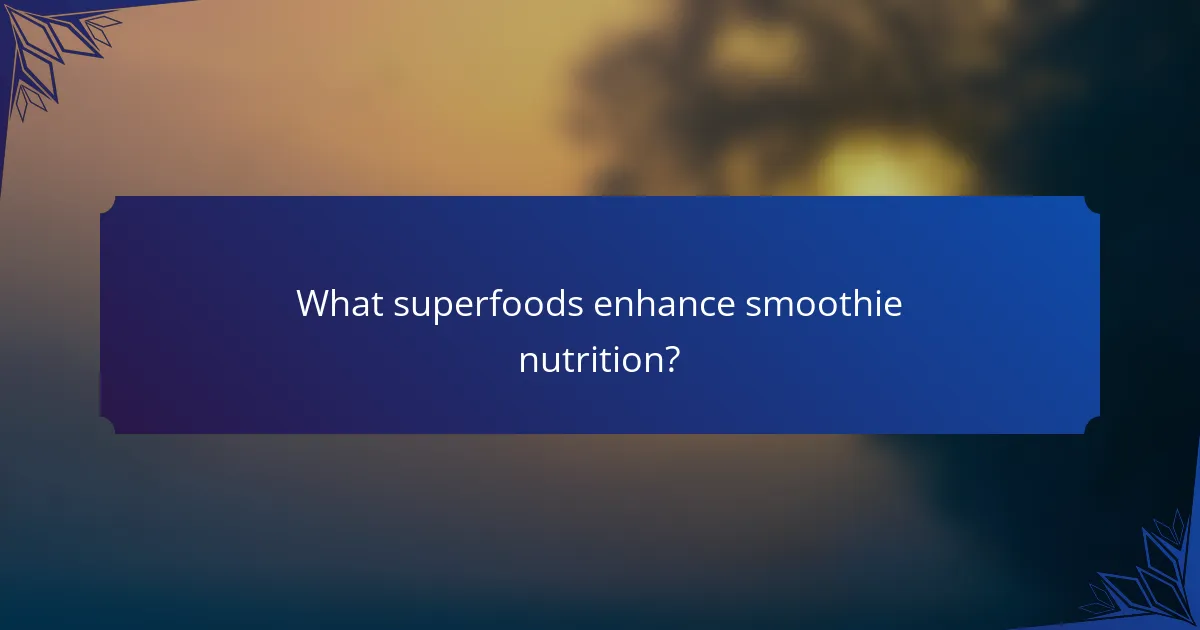Smoothies are a fantastic way to boost energy levels and enhance overall nutrition by combining a variety of nutrient-dense ingredients. By incorporating superfoods like acai berries and spirulina, you can elevate the antioxidant and protein content of your drink. Utilizing effective preparation methods, such as proper blending techniques and layering ingredients, ensures a delicious and refreshing smoothie experience.

How can smoothies boost energy levels?
Smoothies can significantly enhance energy levels by providing a blend of nutrients that fuel the body. Ingredients rich in vitamins, minerals, and natural sugars contribute to sustained energy without the crash associated with processed sugars.
Incorporating spinach for iron
Adding spinach to smoothies is an effective way to boost iron intake, which is essential for energy production. Iron helps transport oxygen in the blood, improving overall stamina and reducing fatigue.
To maximize iron absorption, pair spinach with vitamin C-rich ingredients like oranges or strawberries. A handful of spinach blended into your smoothie can provide a nutritious boost without altering the flavor significantly.
Using bananas for natural sugars
Bananas are an excellent source of natural sugars, providing a quick energy boost. They contain carbohydrates that are easily digestible, making them ideal for pre- or post-workout smoothies.
Incorporate one medium banana per serving to enhance sweetness and creaminess. This fruit also offers potassium, which helps prevent muscle cramps during physical activity.
Adding chia seeds for omega-3s
Chia seeds are a powerhouse of omega-3 fatty acids, which play a crucial role in brain function and energy metabolism. Including chia seeds in your smoothie can help improve endurance and overall energy levels.
Start with one to two tablespoons of chia seeds per smoothie. They absorb liquid and expand, adding a satisfying texture while providing essential nutrients. Soaking them beforehand can enhance their digestibility and nutrient absorption.

What superfoods enhance smoothie nutrition?
Superfoods like acai berries, maca powder, and spirulina can significantly boost the nutritional value of smoothies. Incorporating these ingredients can enhance antioxidant levels, improve stamina, and increase protein content, making your smoothie not only delicious but also a powerhouse of nutrition.
Acai berries for antioxidants
Acai berries are renowned for their high antioxidant content, which helps combat oxidative stress in the body. These small, dark purple fruits are rich in anthocyanins, which are compounds that may support heart health and reduce inflammation.
When adding acai to your smoothie, consider using frozen acai puree or powder. A typical serving is about 100 grams of puree or 1-2 tablespoons of powder, which can easily blend with other fruits and liquids for a nutrient-rich drink.
Maca powder for stamina
Maca powder is derived from a root vegetable native to the Andes and is known for its potential to enhance energy and stamina. It is often used by athletes and those looking to improve their physical performance.
To incorporate maca into your smoothie, start with 1 teaspoon and gradually increase to 1 tablespoon as you adjust to its flavor. It pairs well with chocolate or vanilla-flavored smoothies, adding a nutty taste while providing essential vitamins and minerals.
Spirulina for protein
Spirulina is a blue-green algae that is packed with protein, containing about 60-70% protein by weight. This superfood is an excellent option for those looking to boost their protein intake, especially in plant-based diets.
Adding spirulina to your smoothie can be as simple as including 1-2 teaspoons of the powder. It has a strong flavor, so it works best when combined with fruits like bananas or berries that can mask its taste while still delivering a nutritious punch.

What are the best preparation methods for smoothies?
The best preparation methods for smoothies involve selecting the right blending techniques, layering ingredients effectively, and utilizing frozen fruits for a refreshing chill. These strategies ensure a smooth texture, balanced flavors, and an enjoyable drinking experience.
Blending techniques for optimal texture
To achieve the best texture in smoothies, start by using a high-speed blender. This type of blender can break down fibrous ingredients like leafy greens and frozen fruits efficiently, resulting in a creamy consistency.
Begin by adding liquids first, followed by softer ingredients, and then harder items like ice or frozen fruits. This layering helps the blades move smoothly through the mixture, reducing the chances of clumping.
Layering ingredients for flavor
Layering ingredients strategically can enhance the flavor profile of your smoothie. Start with a base of liquid, such as almond milk or yogurt, followed by fruits and vegetables, and finish with any add-ins like protein powder or superfoods.
Consider using a mix of sweet and tart fruits, such as bananas and berries, to create a balanced taste. Experimenting with spices like cinnamon or ginger can also add depth to the flavor.
Using frozen fruits for chill
Incorporating frozen fruits is an effective way to chill your smoothie without diluting it with ice. Frozen bananas, berries, and mangoes not only provide a refreshing temperature but also contribute natural sweetness and creaminess.
When using frozen fruits, you can reduce the amount of ice needed, which helps maintain the smoothie’s flavor intensity. Aim for a ratio of about one part frozen fruit to two parts fresh ingredients for optimal results.

How to choose the right supplements for smoothies?
Selecting the right supplements for smoothies involves understanding your nutritional needs and evaluating product quality. Focus on ingredients that align with your health goals, such as protein, vitamins, or antioxidants, while ensuring the brand’s credibility and transparency.
Identifying dietary needs
Begin by assessing your personal dietary requirements. Consider factors like your activity level, health goals, and any dietary restrictions. For instance, if you’re looking to boost energy, you might prioritize protein or adaptogenic herbs.
Common dietary needs include increased protein intake for muscle recovery, added fiber for digestive health, or specific vitamins for immune support. Tailor your supplement choices to fill these gaps effectively.
Evaluating supplement brands
When choosing supplement brands, look for those that provide clear ingredient sourcing and third-party testing. Reputable brands often display certifications like NSF or USP, which indicate quality and safety.
Compare products based on their ingredient lists, avoiding those with excessive fillers or artificial additives. Reading customer reviews can also provide insights into the effectiveness and taste of the supplements, helping you make an informed decision.

What are the benefits of meal replacement smoothies?
Meal replacement smoothies offer a convenient way to obtain essential nutrients while saving time. They can be tailored to meet individual dietary needs, making them a versatile option for busy individuals seeking a quick and healthy meal alternative.
Convenience for busy lifestyles
Meal replacement smoothies are ideal for those with hectic schedules, as they can be prepared in minutes. Simply blend your favorite ingredients, such as fruits, vegetables, and protein sources, for a nutritious meal on the go.
Many people find it easier to consume smoothies rather than sit down for a full meal, especially during busy mornings or between meetings. Preparing smoothies in advance and storing them in the refrigerator can further enhance convenience, allowing for quick access when needed.
Weight management support
Incorporating meal replacement smoothies into your diet can aid in weight management by providing a controlled calorie intake. By replacing higher-calorie meals with nutrient-dense smoothies, individuals can create a calorie deficit that supports weight loss.
When preparing smoothies for weight management, focus on including high-fiber ingredients, such as leafy greens and fruits, which can help increase satiety. Avoid adding excessive sugars or high-calorie additives to maintain a balanced nutritional profile.

How do smoothies fit into a balanced diet?
Smoothies can be a nutritious addition to a balanced diet, providing essential vitamins, minerals, and energy. When made with whole ingredients, they can support overall health and complement meals or snacks.
Incorporating Superfoods
Superfoods like spinach, kale, and berries can enhance the nutritional profile of smoothies. These ingredients are rich in antioxidants, vitamins, and minerals, which can boost immunity and overall well-being.
To incorporate superfoods, aim for a variety of colors and types. For example, adding a handful of spinach and a cup of mixed berries can create a nutrient-dense smoothie that supports health goals.
Energy Boosts
For an energy boost, include ingredients like bananas, oats, or nut butters in your smoothies. These foods provide carbohydrates and healthy fats that can sustain energy levels throughout the day.
Consider blending a banana with a tablespoon of almond butter and some oats for a filling, energizing smoothie. This combination can help keep you satisfied and energized, especially before or after workouts.
Preparation Methods
Preparing smoothies can be simple and quick, requiring just a blender and a few ingredients. Start by adding liquid, such as water or milk, followed by fruits, vegetables, and any additional superfoods.
To ensure a smooth texture, blend the ingredients in stages, starting with the liquid and leafy greens, then adding frozen fruits or ice. This method helps achieve a creamy consistency without lumps.
